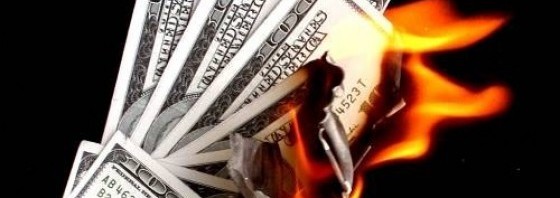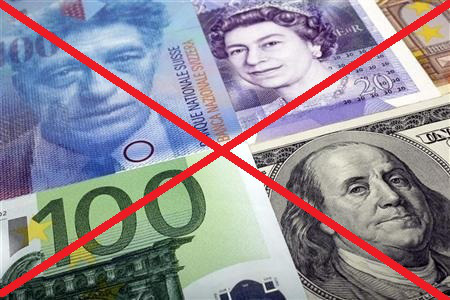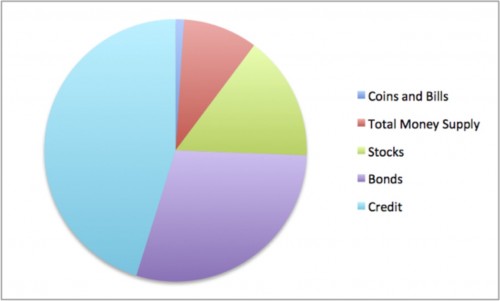The Central Banks hate physical cash. So much so they there will likely try to ban it in the near future.
You see, almost all of the “wealth” in the financial system is digital in nature.
- The total currency (actual cash in the form of bills and coins) in the US financial system is a little over $1.36 trillion.
- When you include digital money sitting in short-term accounts and long-term accounts then you’re talking about roughly $10 trillion in “money” in the financial system.
- In contrast, the money in the US stock market (equity shares in publicly traded companies) is over $20 trillion in size.
- The US bond market (money that has been lent to corporations, municipal Governments, State Governments, and the Federal Government) is almost twice this at $38 trillion.
- Total Credit Market Instruments (mortgages, collateralized debt obligations, junk bonds, commercial paper and other digitally-based “money” that is based on debt) is even larger $58.7 trillion.
- Unregulated over the counter derivatives traded between the big banks and corporations is north of $220 trillion.
When looking over these data points, the first thing that jumps out at the viewer is that the vast bulk of “money” in the system is in the form of digital loans or credit (non-physical debt).
Put another way, actual physical money or cash (as in bills or coins you can hold in your hand) comprises less than 1% of the “money” in the financial system.
As far as the Central Banks are concerned, this is a good thing because if investors/depositors were ever to try and convert even a small portion of this “wealth” into actual physical bills, the system would implode (there simply is not enough actual cash).
Remember, the current financial system is based on debt. The benchmark for “risk free” money in this system is not actual cash but US Treasuries.
In this scenario, when the 2008 Crisis hit, one of the biggest problems for the Central Banks was to stop investors from fleeing digital wealth for the comfort of physical cash. Indeed, the actual “thing” that almost caused the financial system to collapse was when depositors attempted to pull $500 billion out of money market funds.
A money market fund takes investors’ cash and plunks it into short-term highly liquid debt and credit securities. These funds are meant to offer investors a return on their cash, while being extremely liquid (meaning investors can pull their money at any time).
This works great in theory… but when $500 billion in money was being pulled (roughly 24% of the entire market) in the span of four weeks, the truth of the financial system was quickly laid bare: that digital money is not in fact safe.
To use a metaphor, when the money market fund and commercial paper markets collapsed, the oil that kept the financial system working dried up. Almost immediately, the gears of the system began to grind to a halt.
When all of this happened, the global Central Banks realized that their worst nightmare could in fact become a reality: that if a significant percentage of investors/ depositors ever tried to convert their “wealth” into cash (particularly physical cash) the whole system would implode.
As a result of this, virtually every monetary action taken by the Fed since this time has been devoted to forcing investors away from cash and into risk assets. The most obvious move was to cut interest rates to 0.25%, rendering the return on cash to almost nothing.
However, in their own ways, the various QE programs and Operation Twist have all had similar aims: to force investors away from cash, particularly physical cash.
After all, if cash returns next to nothing, anyone who doesn’t want to lose their purchasing power is forced to seek higher yields in bonds or stocks.
The Fed’s economic models predicted that by doing this, the US economy would come roaring back. The only problem is that it hasn’t. In fact, by most metrics, the US economy has flat-lined for several years now, despite the Fed having held ZIRP for 5-6 years and engaged in three rounds of QE.
As a result of this… mainstream economists at CitiGroup, the German Council of Economic Experts, and bond managers at M&G have suggested doing away with cash entirely.
If you think this sounds like some kind of conspiracy theory, consider that France has a cash ban on any transaction over €1,000 Euros from using physical cash. Spain has a cash ban on transactions over €2,500. Uruguay has cash bans on transactions over $5,000. And on and on.
A cash ban will be coming to the US in the near future. Already, the big banks (the ones with the closest ties to the Federal Reserve) have begun turning away deposits OR charging them.
State Street Corp. , the Boston bank that manages assets for institutional investors, for the first time has begun charging some customers for large dollar deposits, people familiar with the matter said. J.P. Morgan Chase & Co., the nation’s largest bank by assets, has cut unwanted deposits by more than $150 billion this year, in part by charging fees…
And here’s another big “tell”…
“At some point you wonder whether there will be a shortage of financial institutions willing to take on these balances,” said Kelli Moll, head of Akin Gump Strauss Hauer & Feld LLP’s hedge-fund practice in New York, saying that where to hold cash has become an increasing topic of conversation as hedge funds are shown the door by longtime banking counterparties.
So where is the physical cash meant to go?
Jerome Schneider, head of Pacific Investment Management Co.’s short-term and funding desk, which advises corporate and institutional clients, said that as a result of the bank actions, he and his customers have discussed as cash alternatives boosting investments in U.S. Treasury bonds, ultrashort-duration bond funds and money-market funds.
When it comes to cash, Mr. Schneider said, “Clients have been put on warning.”
Source: Wall Street Journal.
This is just the beginning. Indeed… we’ve uncovered a secret document outlining how the US Federal Reserve plans to incinerate savings.
We detail this paper and outline three investment strategies you can implement
right now to protect your capital from the Fed’s sinister plan in our Special Report
Survive the Fed’s War on Cash.
We are making 1,000 copies available for FREE the general public.
To pick up yours, swing by….
http://www.phoenixcapitalmarketing.com/cash.html
Best Regards
Graham Summers
Chief Market Strategist
Phoenix Capital Research









